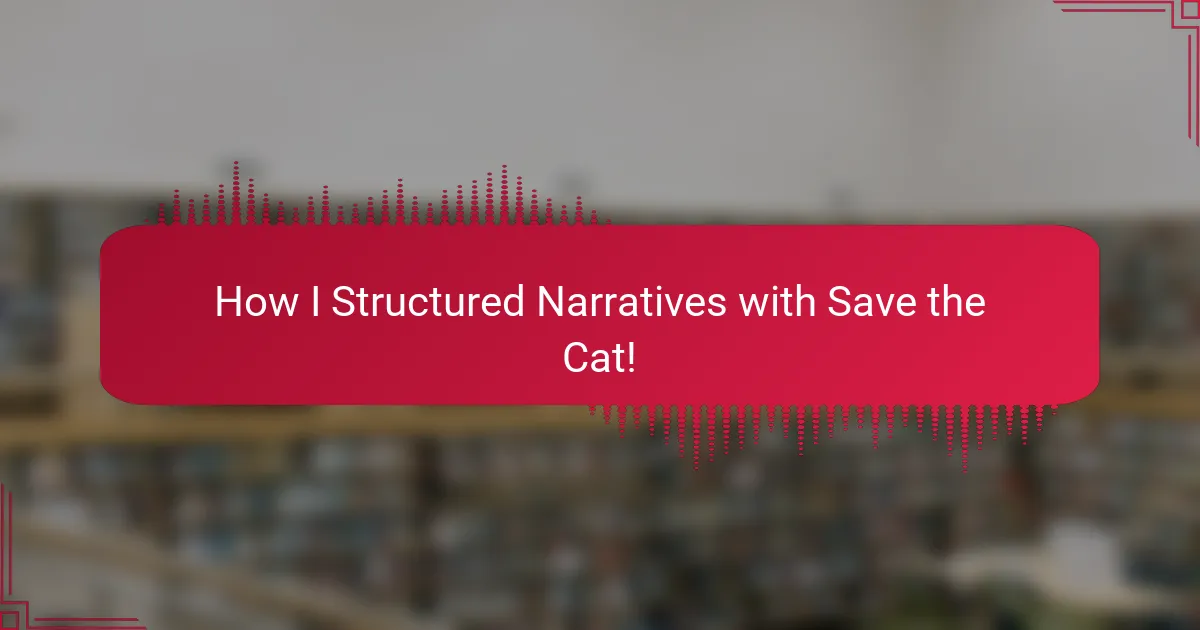Key takeaways
- Save the Cat offers a character-driven storytelling method with a clear structure of 15 essential beats, enhancing relatability and emotional connection.
- Narrative structure is crucial for pacing and character development, significantly improving reader engagement in comic books.
- Key principles include the “Save the Cat” moment to foster empathy, and a focus on character and plot pacing to create compelling narratives.
- Effective application of the Save the Cat method involves balancing action with emotional depth, ensuring every panel contributes to the narrative flow.
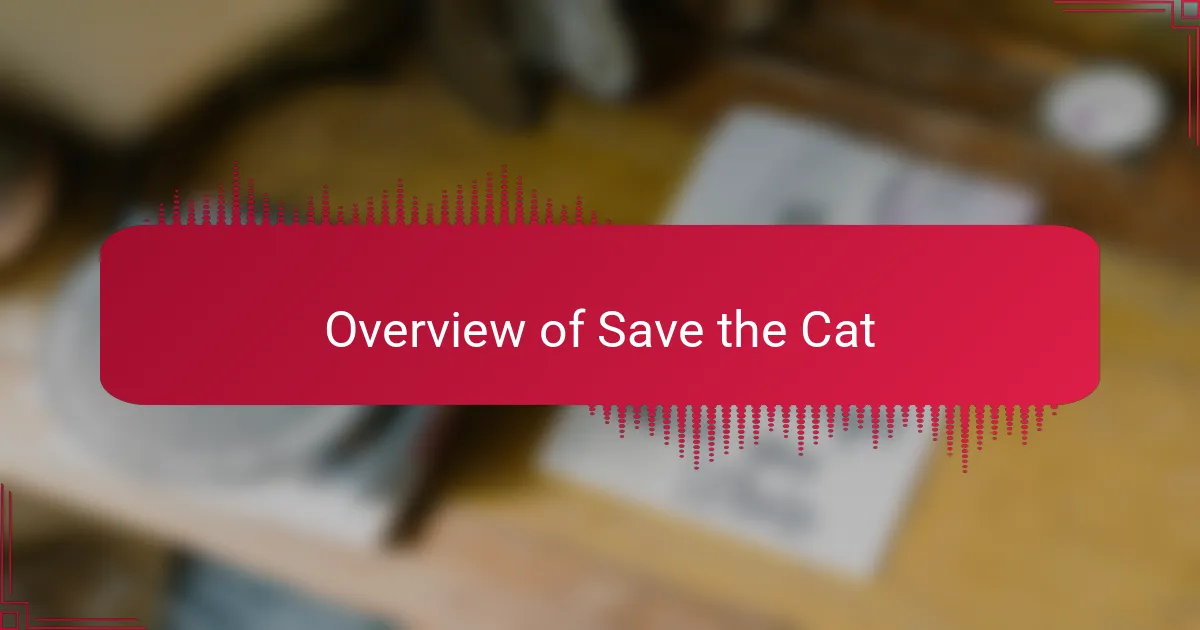
Overview of Save the Cat
Save the Cat is a storytelling methodology created by Blake Snyder that focuses on crafting compelling narratives. I first encountered this approach while developing my comic book scripts, and it has since become an invaluable tool in my creative toolbox. The essence of Save the Cat lies in its clear structure and relatable themes, making it easier for writers to connect with audiences.
What I find particularly engaging about Save the Cat is its practical beat sheet, which breaks down a story into 15 essential beats. This framework helps in maintaining pacing and character development, ensuring every element of the story serves a purpose. It’s like having a roadmap that guides you through the intricate journey of storytelling.
Here’s a quick comparison of Save the Cat’s key elements versus traditional narrative structures:
| Aspect | Save the Cat | Traditional Structures |
|---|---|---|
| Focus | Character-driven with relatable themes | Plot-driven, often less emphasis on character |
| Structure | 15 beats guiding the narrative | 3-act structure or hero’s journey |
| Accessibility | Beginner-friendly, easy to understand | Can be complex and nuanced |
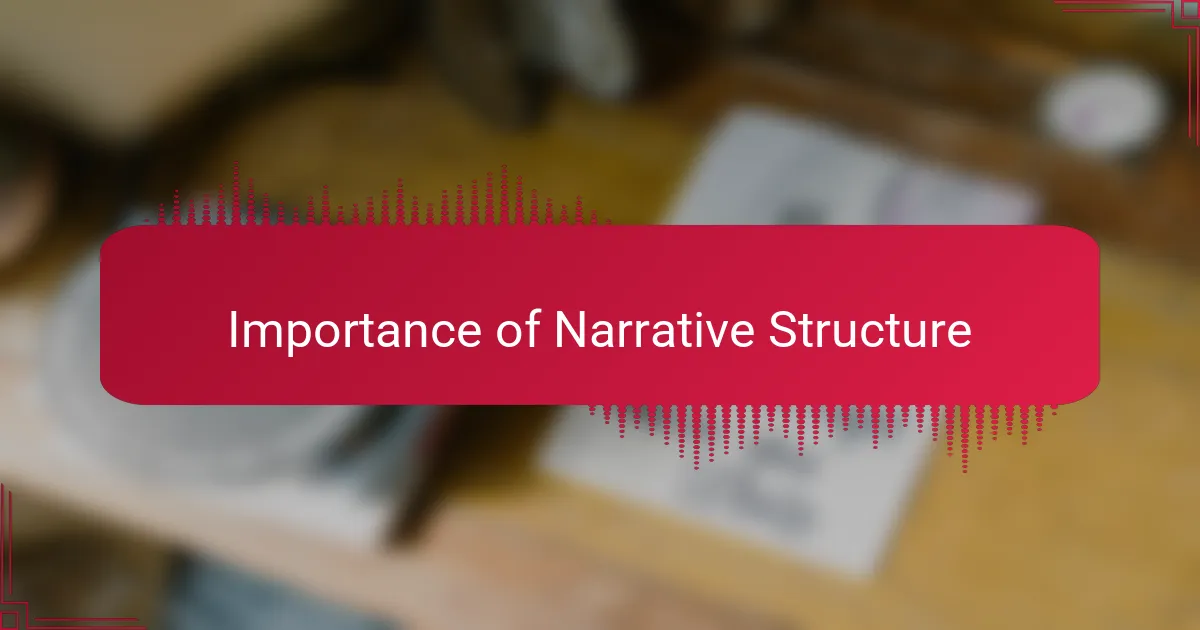
Importance of Narrative Structure
Narrative structure serves as the backbone of any compelling story, especially in the dynamic world of comic books. From my experience, a well-structured narrative not only keeps readers engaged but also ensures that every scene contributes meaningfully to character development and plot progression. I remember my first comic where I struggled with pacing, only to realize later that adhering to a clear structure helped me refine the story, making it more impactful.
When I discovered the Save the Cat method, it transformed my writing process. This approach emphasizes key story beats, making it easier to plot out essential moments and emotional arcs. I found that by dividing my story into specific components, I could focus on creating more relatable characters and scenarios that resonate deeply with my audience. The clarity it brought to my storytelling is invaluable.
- Establishes a clear roadmap for the plot.
- Enhances character arcs and emotional depth.
- Improves pacing, keeping readers engaged.
- Provides structure to scenes and dialogue.
- Makes it easier to identify and fix story flaws.
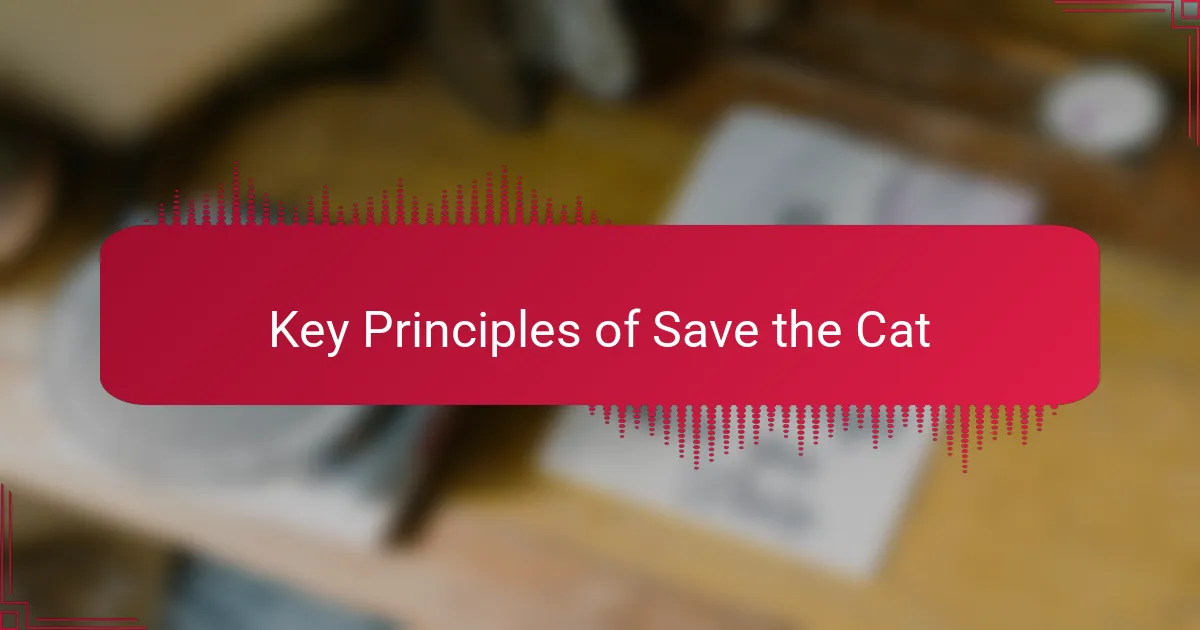
Key Principles of Save the Cat
When I first encountered the “Save the Cat” method, I was intrigued by its straightforward approach to storytelling. One of the key principles is the “Save the Cat” moment itself, where the protagonist does something endearing early in the narrative, inviting readers to empathize with them. This emotional connection can be crucial in comic book storytelling, where character relatability often drives audience engagement.
Another essential element is the structure of the story, divided into 15 distinct beats. I’ve found that adhering to these beats helps maintain narrative momentum, allowing for both tension and resolution. This structure not only guides the plot but also reminds me to keep my audience invested in the characters’ journeys.
For anyone venturing into comic book writing, understanding these principles can transform your approach. By focusing on character development and plot pacing, you can create a compelling narrative that resonates with readers on a deeper level.
| Key Principle | Description |
|---|---|
| Save the Cat Moment | A moment where the protagonist performs an endearing act to garner empathy. |
| 15 Beats Structure | A clear outline of plot progression that maintains audience engagement. |
| Character Relatability | Building emotional connections between characters and readers through shared experiences. |
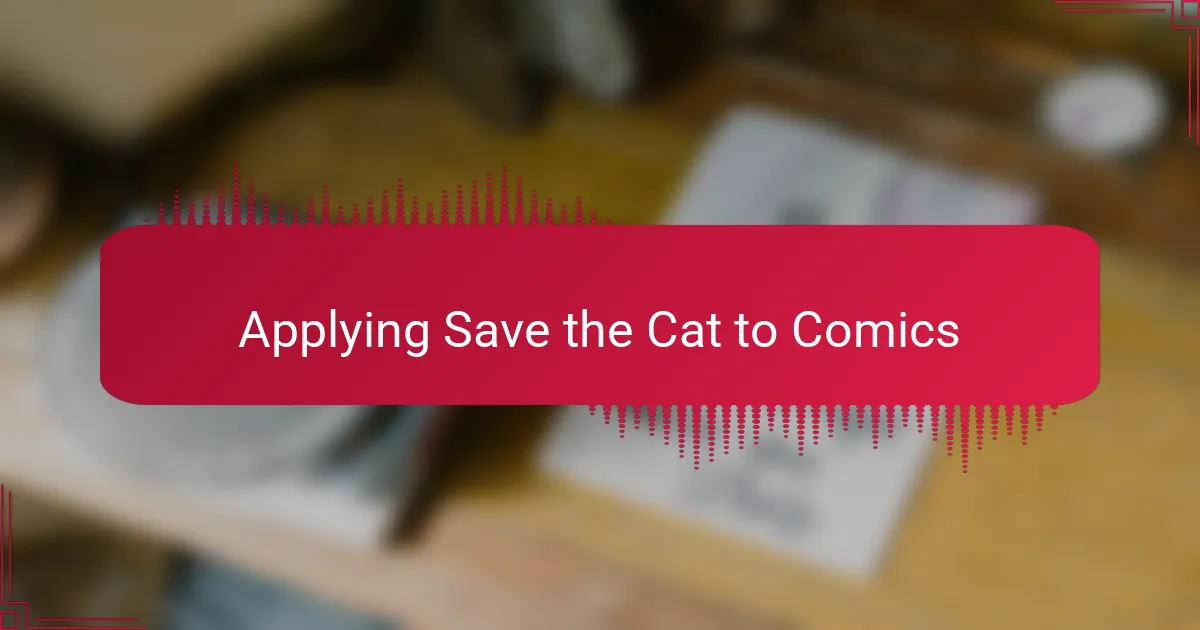
Applying Save the Cat to Comics
Applying the Save the Cat structure to comics has transformed my storytelling approach. I remember when I first encountered the beat sheet; it was like uncovering a treasure map for my narratives. Understanding the importance of a strong opening—what the Save the Cat method calls the “Set-Up”—has helped me anchor my characters and themes right from page one. This initial hook keeps readers invested in the story and eager to turn each page.
When crafting a comic, I also find the “Fun and Games” beat essential. This is the heart of the story, where characters engage in unique adventures that showcase their personalities. I realized that blending humor, excitement, and unexpected twists during this section can elevate the reader’s experience. The Save the Cat approach ensures that every panel serves a purpose while keeping the journey engaging and relatable.
Here are some key beats from the Save the Cat method that I apply in my comics:
- Opening Image: Establish the tone and setting right from the first panel.
- Set-Up: Introduce characters and their world, hinting at their future arcs.
- The Catalyst: Present the event that propels the protagonist into action.
- Debate: Show the protagonist’s internal struggle, raising stakes and tension.
- Fun and Games: Develop key themes with action-packed and entertaining sequences.
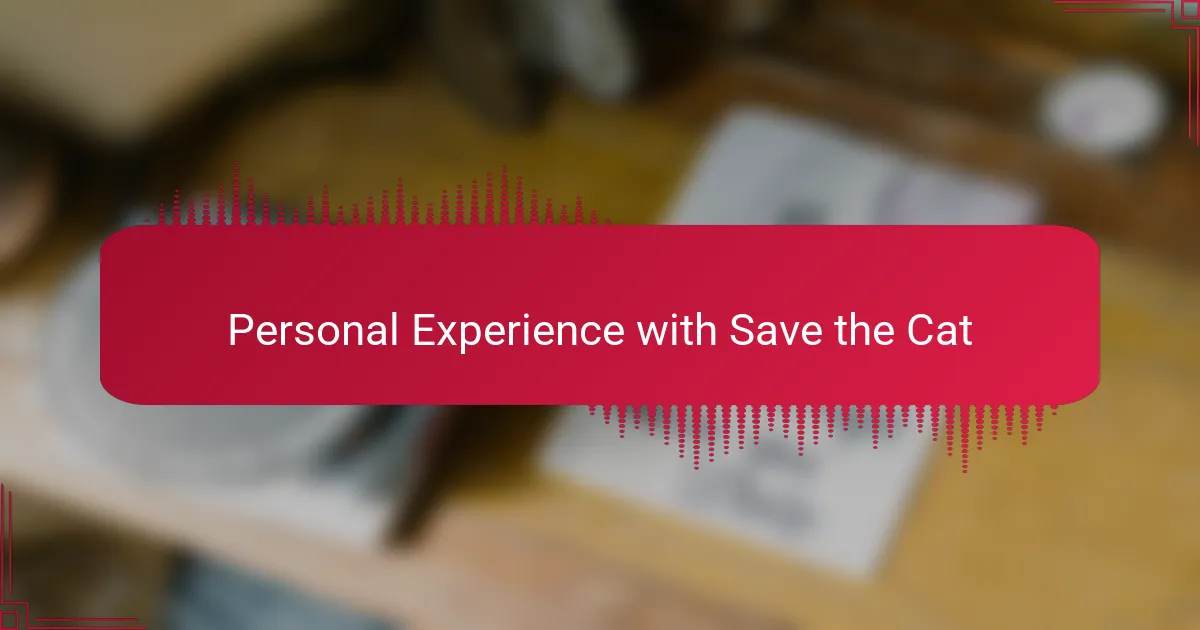
Personal Experience with Save the Cat
When I first encountered “Save the Cat,” it was like a lightbulb went off in my creative process. I vividly remember struggling with pacing and structure in my early comic book scripts. This system provided me with a clear roadmap, making it easier to identify pivotal moments in my stories and ensuring that my characters had enough depth to resonate with readers.
Through my journey, I’ve adapted the “Save the Cat” beat sheet to fit the comic book format, which proved to be a game changer. I learned to apply each beat thoughtfully, aligning them with visual storytelling elements that comics excel at. Here’s how I’ve structured my narratives using this method:
- Opening Image: Establishes the tone and introduces the main character’s world.
- Theme Stated: Early hints about the central conflict or theme that will unfold.
- Set-Up: Key details about the protagonist and their relationships that set the stage for conflict.
- Catalyst: The event that propels the hero into action, often giving a jolt of excitement.
- Debate: Illustrates the protagonist’s internal struggle about taking action, adding emotional depth.
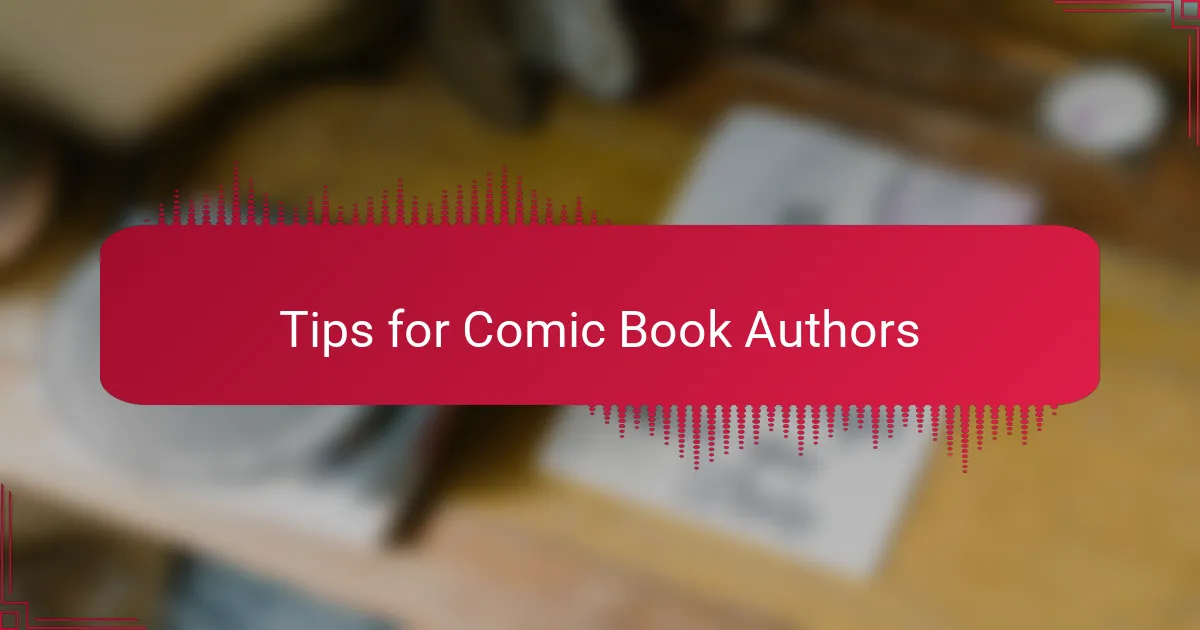
Tips for Comic Book Authors
When crafting a comic book, I’ve found that clarity is crucial in both storytelling and visuals. I often remind myself that each panel should drive the narrative forward, much like a well-timed beat in music. Think about how your characters’ emotions translate visually; this connection can make your audience feel like they’re part of the journey. Have you considered how an emotional moment feels on the page? I believe it’s essential to capture that essence.
Dialogue is another vital component that can elevate your story. I once struggled with creating natural conversations, but using the “Save the Cat” method helped me focus on what each character truly wants in a scene. When characters engage in dialogue, it should feel authentic and reflect their personalities. Engaging in small talk can reveal much about your characters. Are your instances of dialogue adding depth, or do they simply serve as filler?
Lastly, don’t underestimate the power of pacing. I recall a comic where I rushed through crucial moments, only to later realize how those scenes could have benefited from more breathing room. Using the Save the Cat framework taught me that balancing action with quieter moments enhances the reader’s emotional connection. How do you balance action and reflection in your work? Finding that rhythm can significantly impact how your audience experiences your story.
